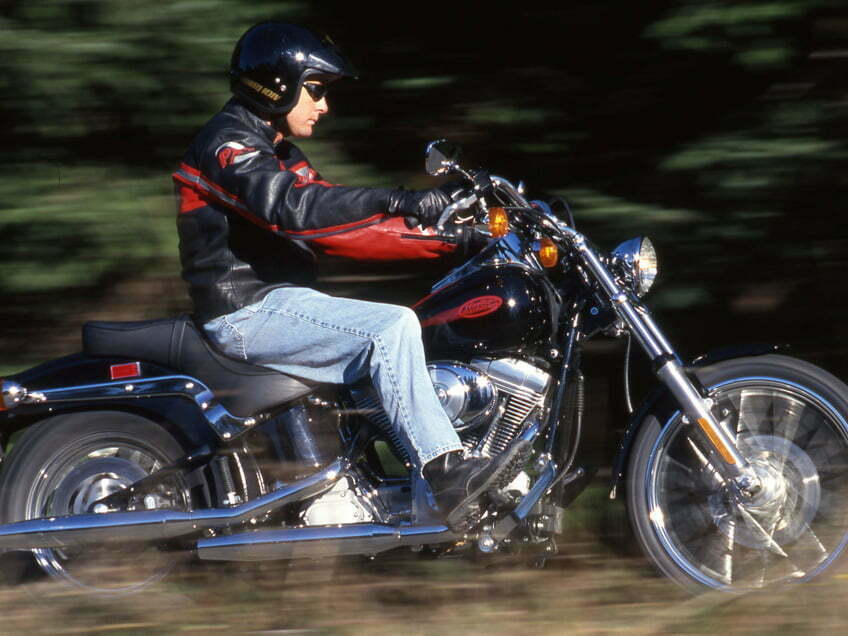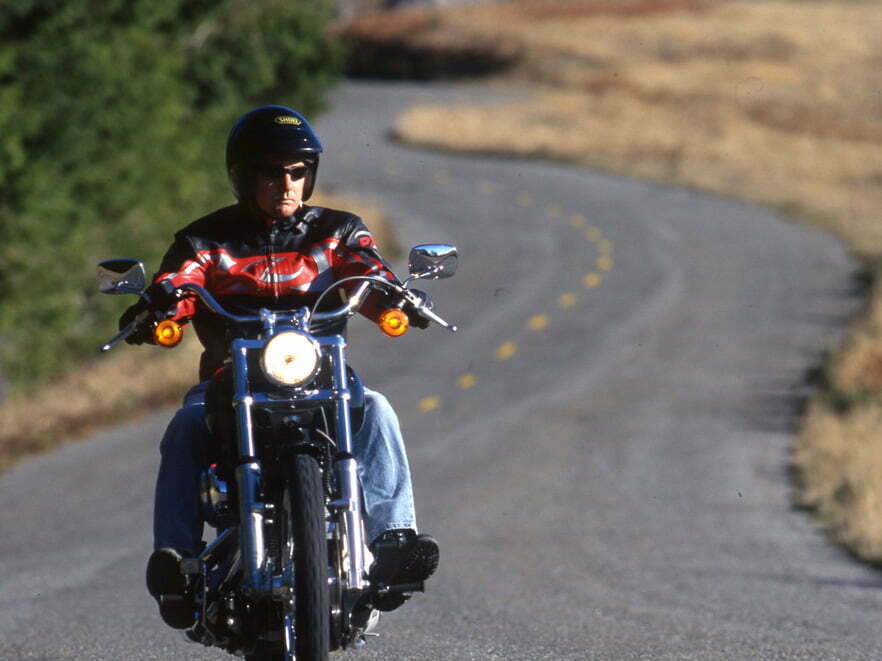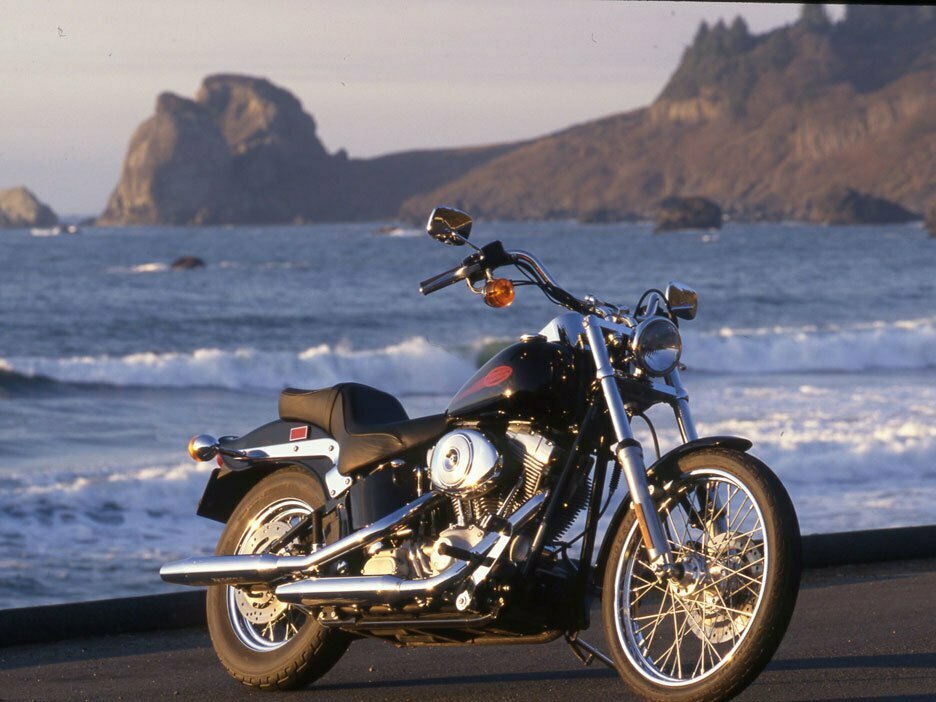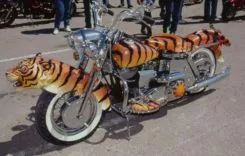Riding Impression of the 2000 Harley-Davidson FXST Softail Standard
It’s not the best thing about the 2000 FXST Softail Standard, but it’s a very important thing: the price. At $12,645 in basic black with wire-spoked wheels, the Standard is only price-tagged a little more than three grand above the Sportster Custom also reviewed. And it’s only about a thousand bucks above the base FXD Dyna Glide.
So, then, just what is the best thing about the FXST? It’s what you get for that money: the new Twin Cam Beta engine and the new Softail chassis. Those two elements alone have changed everything. Forget the old Softie and all of the impressions of it you may have; they no longer apply to this different beast.
You know it the first time you fire it up. The engine revs like an Evo running nitro, and it does it so smoothly that you really want to try one of those automotive “my car is smoother than yours” clichés, like balancing a quarter on the gas tank. You probably couldn’t do it at idle, but you wouldn’t feel stupid trying it.
The reasons for this smoothness, which have been much discussed in the pages of this and other magazines, are the new twin, contra-rotating balancers that have been added to the Beta version of the Twin Cam 88. These quell vibration at the source, rather than isolating it as rubber engine mounts do. The difference between any Dyna and a new Softail is obvious: The Softail is actually smoother down low, though a little buzzier up high, all while allowing those desirable bits of engine feel to reach you—i.e., the torque pulses and the textures that give an engine, and the motorcycle in which it resides, real character.

Blip the throttle with the clutch disengaged, and the revs pick up much more quickly than on an Evo.
Jeff Allen
Less discussed anywhere is the reason for the quicker revving of the Beta engines. Evo Big Twins had enormously heavy cranks, a holdover from life before modern carburetors and ignition systems. Back when magnetos fired a wispy spark across a narrow plug gap, and carburetors mixed fuel and air with all the precision of a bartender who’d been sampling his own product all night, engines needed those big flywheels because they simply didn’t fire on every revolution, particularly at idle. The millwheel-sized flywheels were there to carry the engine through those misfires, and to smooth its rough running when accelerating from low rpm. But such conditions no longer exist; try building an engine that behaves this way today and the EPA would never let you sell it. Instead, modern carburetors meter with uncanny precision, and modern ignitions could almost double as arc welders. Harley finally took advantage of those technologies with the first Twin Cam 88, giving it almost 30 percent less flywheel effect than the Evo.
The Beta takes that design philosophy a little farther. To work properly with the new counterbalancers, the crankshaft is counterweighted at a balance factor of just 50 percent, which means it has smaller counterweights than the other Twin Cam engines, which have closer to a 60-percent factor. The result is even less flywheel effect than in Twin Cam Alphas, and an engine that pays attention to the throttle. Blip the throttle with the clutch disengaged, and the revs pick up much more quickly than on an Evo. That increased responsiveness is something that comes with every ride on the Softail, and is a joy beyond the newfound power and improved acceleration. All that flywheel to the engine was like a 50-pound pack to a soldier: Both just simply feel lighter and quicker without it.
Complementing that newfound engine responsiveness is the new chassis, which looks much like that of the old Softail while being dramatically stiffer. The gearbox bolts to the Beta engine so solidly as to almost be an integral part, so the engine assembly braces the frame by design. Consequently, when you turn the handlebar, the FXST turns, right now, with no chassis wind-up. To the rider, this solidity translates into a feeling of control that fosters rider confidence. “Go ahead,” the bike whispers to you, “take that corner faster, and I’ll help out.”
All this is quite a role-reversal for the Softails. A stock Evo Softail came with the tallest gearing of any model in the H-D lineup, and its engine always felt lazy and unwilling. No wonder Softail owners rushed to install new cams, carbs and pipes. And while the handling of an Evo Softail was adequate, it was just that—adequate. But now here comes the new FXST, and suddenly a Softail feels sportier than a Dyna. Talk about a change!
Further dramatic improvements have come via the internal shifting mechanism and the new four-piston brakes. By changing to a lighter shift drum, providing a positive stop that prevents over-rotation of the drum during a fast shift, and eliminating friction in the entire gearchanging system, Harley has created the best-shifting Big Twin ever, one that “clicks” rather than “CLANGS!” into the next gear. The Softail still has a very precise, very mechanical shifting feel that is totally different than the extremely light action that you get with some imported machines; but damn, does it feel good. Likewise, the new brakes reduce control efforts while adding to precision. They haul the Softail down with the alacrity of running into a cyclone fence, but with a lot less drama.

Softails have never been known as pleasant long-range bikes or effective corner-carvers. Until now.
Jeff Allen
Despite their vast functional improvements and sportier character, the new Softails nonetheless retain the elements that have made these hardtail-look models such big hits since their introduction in 1984. Virtually every piece of the 2000 Softails has been redesigned in some way, yet they still have that long and low, custom appearance.
And the Standard, the lowest-priced Softail of them all, arguably has some of the most attractive cosmetics. Instead of a black-and-chrome engine, it get one finished in Harley’s aluminum-look powdercoat that almost perfectly mimics a bead-blast finish on bare aluminum—but that can be easily wiped clean of road grime and oil. That bare-metal look, combined with the clean silvers of the polished fins and rocker boxes, emphasizes the muscularity of the Beta engine and demonstrates just how massively attractive it can be. Similarly, the black-finished oil tank—rather than chrome-plated—doesn’t visually distract from the engine and makes the new chromed oil lines stand out. Like other Softails, the Standard gets a new, one-piece fuel tank, but visually, it’s a dead-nuts-on replica of the traditional twin-tank design.
The FXST’s riding position remains that long-legged stretch to forward-mounted controls that a whole generation of riders has learned to love. The handlebar is wide and leans you back slightly, and, along with the engine’s smoothness, help make the Softail a perfectly reasonable long-distance machine. Just throw a set of bags over the back and head for the coast—the opposite one, that is.
If and when you do head out on the highway, the FXST is perfectly happy carrying you along in the fast lane comfortably and quickly. Even at 85 or so, where the counterbalancers finally start to slack off a bit and let just a hint of buzzing to escape, the new Softail is so much smoother than its predecessor that there is little to gripe about.
Any other complaints? Well, it would have been nice if Harley had fitted the wide rear tire of the new Deuce across the entire Softail range; we suspect that’ll take a year or two to work its way down the line. But the main reason to want that 150-section rear radial is imagining what this bike would be like with a 1550 kit installed. Yes, yes, the bike already is so quick and agile stock that the 94-inch kit might seem like excess; but then again, a Softail has never been about compromise. And, as noted in the beginning of this review, a real attraction of this Standard Softail is—possible dealer gouging aside—that it may well leave you with some money to make it quicker or more visually distinctive yet.
Now, that’s attractive.
This article was originally published in the April-May 2000 issue of Big Twin.
RELATED CONTENT: Ken’s Factory’s Custom Heritage Softail

The Standard, the lowest priced Softail of them all, arguably has some of the most attractive cosmetics.
Jeff Allen
| FXST Softail Standard |
|---|
| High Points: |
| The best stock Big Twin engine ever |
| Strong powerful, four-piston brakes |
| Lose your padlock; the ignition key now operates a real forklock built into the steering head |
| Aluminum powdercoat finish on the engine looks like the cases just came from the bead blaster, but is easier to clean than a real bead-blasted finish |
| Low Points: |
| Harley won’t build enough of them, and some dealers may gouge |
| The new brake rotors work nicely, but did Harley have to hit them with an |
| The bike handles so well that it’s all too easy to scratch the pipes |
| It wouldn’t have cost any more to have made the 1550 big-bore kit stock; they’d have just had to adjust the boring bar to cut another 1/8-inch out of the cylinders |







